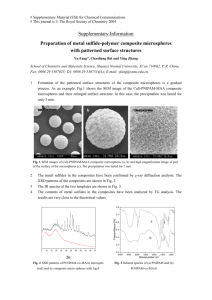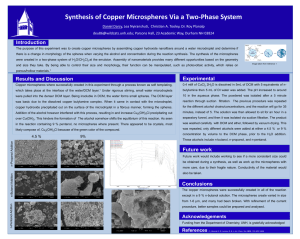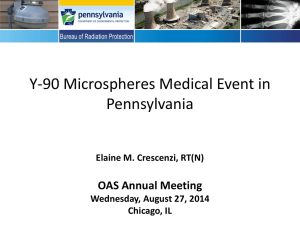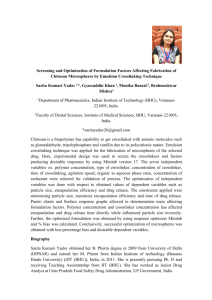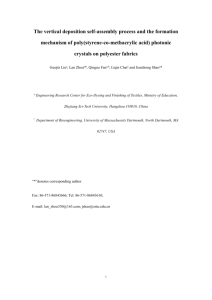Document 13308438
advertisement
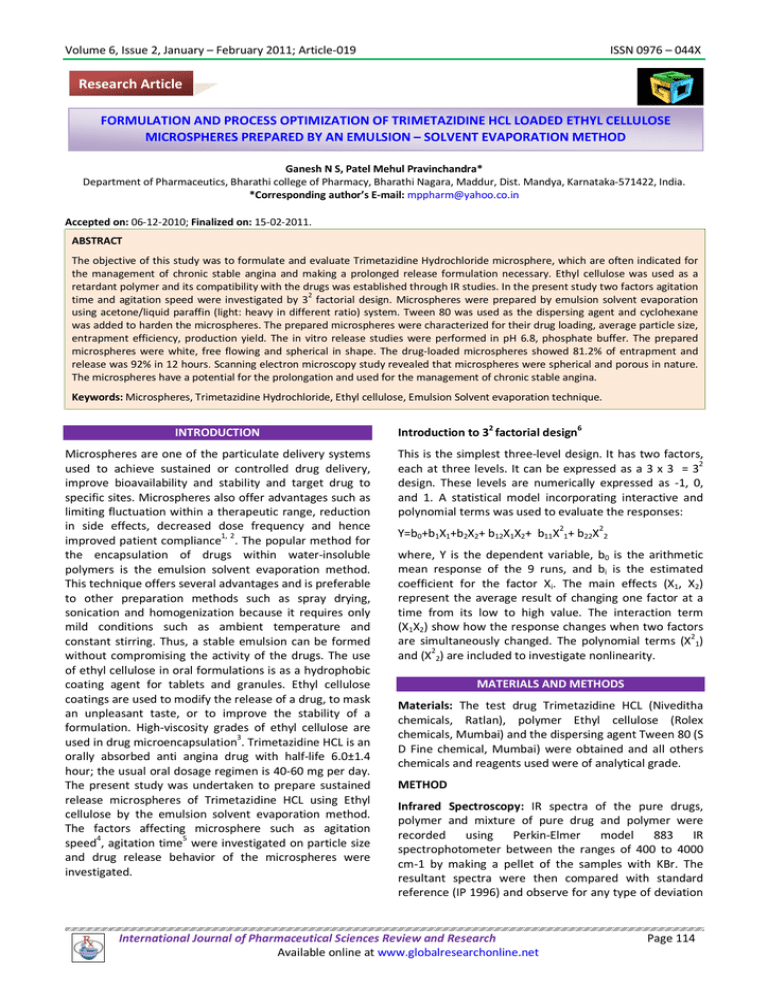
Volume 6, Issue 2, January – February 2011; Article-019 ISSN 0976 – 044X Research Article FORMULATION AND PROCESS OPTIMIZATION OF TRIMETAZIDINE HCL LOADED ETHYL CELLULOSE MICROSPHERES PREPARED BY AN EMULSION – SOLVENT EVAPORATION METHOD Ganesh N S, Patel Mehul Pravinchandra* Department of Pharmaceutics, Bharathi college of Pharmacy, Bharathi Nagara, Maddur, Dist. Mandya, Karnataka-571422, India. *Corresponding author’s E-mail: mppharm@yahoo.co.in Accepted on: 06-12-2010; Finalized on: 15-02-2011. ABSTRACT The objective of this study was to formulate and evaluate Trimetazidine Hydrochloride microsphere, which are often indicated for the management of chronic stable angina and making a prolonged release formulation necessary. Ethyl cellulose was used as a retardant polymer and its compatibility with the drugs was established through IR studies. In the present study two factors agitation 2 time and agitation speed were investigated by 3 factorial design. Microspheres were prepared by emulsion solvent evaporation using acetone/liquid paraffin (light: heavy in different ratio) system. Tween 80 was used as the dispersing agent and cyclohexane was added to harden the microspheres. The prepared microspheres were characterized for their drug loading, average particle size, entrapment efficiency, production yield. The in vitro release studies were performed in pH 6.8, phosphate buffer. The prepared microspheres were white, free flowing and spherical in shape. The drug-loaded microspheres showed 81.2% of entrapment and release was 92% in 12 hours. Scanning electron microscopy study revealed that microspheres were spherical and porous in nature. The microspheres have a potential for the prolongation and used for the management of chronic stable angina. Keywords: Microspheres, Trimetazidine Hydrochloride, Ethyl cellulose, Emulsion Solvent evaporation technique. INTRODUCTION Microspheres are one of the particulate delivery systems used to achieve sustained or controlled drug delivery, improve bioavailability and stability and target drug to specific sites. Microspheres also offer advantages such as limiting fluctuation within a therapeutic range, reduction in side effects, decreased dose frequency and hence improved patient compliance1, 2. The popular method for the encapsulation of drugs within water-insoluble polymers is the emulsion solvent evaporation method. This technique offers several advantages and is preferable to other preparation methods such as spray drying, sonication and homogenization because it requires only mild conditions such as ambient temperature and constant stirring. Thus, a stable emulsion can be formed without compromising the activity of the drugs. The use of ethyl cellulose in oral formulations is as a hydrophobic coating agent for tablets and granules. Ethyl cellulose coatings are used to modify the release of a drug, to mask an unpleasant taste, or to improve the stability of a formulation. High-viscosity grades of ethyl cellulose are used in drug microencapsulation3. Trimetazidine HCL is an orally absorbed anti angina drug with half-life 6.0±1.4 hour; the usual oral dosage regimen is 40-60 mg per day. The present study was undertaken to prepare sustained release microspheres of Trimetazidine HCL using Ethyl cellulose by the emulsion solvent evaporation method. The factors affecting microsphere such as agitation 4 5 speed , agitation time were investigated on particle size and drug release behavior of the microspheres were investigated. Introduction to 32 factorial design6 This is the simplest three-level design. It has two factors, each at three levels. It can be expressed as a 3 x 3 = 32 design. These levels are numerically expressed as -1, 0, and 1. A statistical model incorporating interactive and polynomial terms was used to evaluate the responses: Y=b0+b1X1+b2X2+ b12X1X2+ b11X21+ b22X22 where, Y is the dependent variable, b0 is the arithmetic mean response of the 9 runs, and bi is the estimated coefficient for the factor Xi. The main effects (X1, X2) represent the average result of changing one factor at a time from its low to high value. The interaction term (X1X2) show how the response changes when two factors are simultaneously changed. The polynomial terms (X21) and (X22) are included to investigate nonlinearity. MATERIALS AND METHODS Materials: The test drug Trimetazidine HCL (Niveditha chemicals, Ratlan), polymer Ethyl cellulose (Rolex chemicals, Mumbai) and the dispersing agent Tween 80 (S D Fine chemical, Mumbai) were obtained and all others chemicals and reagents used were of analytical grade. METHOD Infrared Spectroscopy: IR spectra of the pure drugs, polymer and mixture of pure drug and polymer were recorded using Perkin-Elmer model 883 IR spectrophotometer between the ranges of 400 to 4000 cm-1 by making a pellet of the samples with KBr. The resultant spectra were then compared with standard reference (IP 1996) and observe for any type of deviation International Journal of Pharmaceutical Sciences Review and Research Available online at www.globalresearchonline.net Page 114 Volume 6, Issue 2, January – February 2011; Article-019 from the standard. The results of FTIR spectra are given in figure 1. Figure 1: FTIR spectrum of (A) Trimetazidine Hydrochloride (B) Ethyl Cellulose (C) Trimetazidine Hydrochloride + Ethyl Cellulose ISSN 0976 – 044X 2 3 Full Factorial Design Two factors were evaluated and each at three levels and experiment trial were performed at all possible 9 combination. In the present investigation Time duration(X1) and Stirring time (X2) were selected as independent variable. The experimental design and with corresponding formula is outlines in table 1 and 2. Determination of mean particle size8 The particle size was measured using an optical microscope, and the mean particle size was calculated by measuring 200 particles with the help of a calibrated ocular micrometer. A small amount of dry microspheres was suspended in liquid paraffin (10 ml). A small drop of suspension thus obtained was placed on a clean glass slide. The slide containing microspheres was mounted on the stage of the microscope and diameter of at least 100 particles was measured using a calibrated optical micrometer. The mean particle size was calculated and results are given in table 3 and figure 2 for EP1-EP9. Entrapment Efficiency9 Preparation of Ethyl cellulose microspheres7 The Ethyl cellulose microspheres were prepared by solvent evaporation method. 6% W/V solution of polymer was prepared in Acetone. Accurately weighed quantity of Trimetazidine Hydrochloride was added into the polymeric solution. The resulting solution was added drop wise into continuously stirring 150 ml liquid paraffin (mixture of light and heavy liquid paraffin in different ratios) and 2 %v/v of Tween 80. The resulting emulsion was stirred using Remi lab stirred at 1000 RPM for 4 hours to facilitate solvent evaporation. The suspension of microspheres was filtered and the microspheres were hardened with petroleum ether (60°C-80°C). The microspheres were finally washed with n-Hexane and dried at room temperature. Formula optimization of Ethyl cellulose microspheres To determine the entrapment efficiency, 25 mg microspheres were thoroughly triturated and dissolved in minimum amount of water. The resulting solution was made up to 50 ml with water and filtered. Drug content was analyzed spectrophotometrically at 269 nm. The percentage incorporation efficiency and percentage drug loading were calculated using eq. 1& 2 given below and results are given table 3 and figure 3 for EP1-EP9. % Drug loading Actual drug content X 100 ………………1. Weight of microspher es % Incorporation efficiency ………..2. Actual drug content 100 Theoretical drug content Production yield 10 Production yield of microspheres containing a drug was determined by the weight ratio of the dried microspheres to the loading amount of the drug and Polymer. Production yield was calculated using eq..3 & results are given in table 3 and figure 4 for EP1-EP9. Total mass of microspheres Different ratios of drug to polymer and different ratios of % Production Yield 100 …………….3 Total mass of raw materials light to heavy liquid paraffin were studied for preparation of microspheres. The drug to polymer ratios was 1:1, 1:1.5 and 1:2. The heavy to light liquid paraffin ratios were 2:1, 1:1and 1:2. Table 1: Formula for Ethyl cellulose microspheres Batch no. Drug: Polymer Liquid Paraffin (heavy:light) Time duration (X1) Stirring rate (X2) EP1 1:1 1:1 -1 -1 EP2 1:1 1:2 -1 0 EP3 1:1 2:1 -1 1 EP4 1:2 1:1 0 -1 EP5 1:2 1:2 0 0 EP6 1:2 2:1 0 1 EP7 1:1.5 1:1 1 -1 EP8 1:1.5 1:2 1 0 EP9 1:1.5 2:1 1 1 International Journal of Pharmaceutical Sciences Review and Research Available online at www.globalresearchonline.net Page 115 Volume 6, Issue 2, January – February 2011; Article-019 ISSN 0976 – 044X Table 2: Coded Values for stirring time and stirring rate Coded value Stirring time In hours (X1) Stirring rate RPM (X2) -1 3 1000 0 4 1200 1 5 1400 Table 3: Results of % yield, average diameter and % entrapment for Batches EP1 to EP9 Batch no. Stirring time Stirring rate % yield Average diameter ± Std. Dev (µm) % Entrapment ± Std. Dev EP1 3 1000 72.7% 54.5±21.5 78.4±0.92 EP2 3 1200 80.4% 49.5±19.3 74.6±0.64 EP3 3 1400 73.3% 37.5±15.2 81.2± 1.03 EP4 4 1000 74.6% 49.2±25.8 72.2±0.77 EP5 4 1200 77.4% 39.6±16.21 73.7±1.09 EP6 4 1400 75.8% 64.9±38.24 76.5±0.84 EP7 5 1000 78.3% 70.2±49.94 75.4±1.28 EP8 5 1200 80.6% 52.5±22.47 79.5±0.79 EP9 5 1400 72.3% 45.5±13.75 78.3±1.26 Scanning electron microscopy11 Scanning electron microscopy (Jeol JSM-6380LV, Japan) was used to examine the shape and surface morphology of the ethylcellulose microspheres. Samples of microspheres were dusted onto silica gel applied sample holder. The sample holders were then coated with Platinum using a cold sputter coater. The samples were imaged using a 15 kV electron beam. The results of SEM are shown in figure 5. In vitro drug release study of Microspheres11 The drug release rate from microspheres was determined using USP XXIII basket type dissolution apparatus. Accurately weighed amount (100mg) of microspheres were taken for dissolution study. The microspheres were placed in a non reacting muslin cloth that had a smaller mesh size than the microspheres. The mesh was tied with a nylon thread to avoid the escape of any microspheres. Phosphate buffer pH 6.8 was used as the dissolution medium and maintained at 370C at a rotation speed of 100 rpm. Samples of 8 ml each were withdrawn at 1 hr, 2 hr, 4 hr, 6 hr, 8 hr, 10 hr and 12 hr intervals and analyzed spectrophotometrically at 269 nm to determine the concentration of drug present in the dissolution medium. The initial volume of the dissolution fluid was maintained by adding 8 ml of fresh dissolution fluid after each withdrawal. As shown in table 4 and figure 6. The response surface plots of EP1 to EP9. The response surface plot was drawn using Sigma plot software (Jandel Scientific, San Rafael, CA). Figure 8 shows the plot of Average particle size and % drug release after 12 hours versus the Stirring time (X1) and the Stirring rate (X2). International Journal of Pharmaceutical Sciences Review and Research Available online at www.globalresearchonline.net Page 116 Volume 6, Issue 2, January – February 2011; Article-019 ISSN 0976 – 044X Figure 5: Scanning electron microphotographs of microspheres showing their shape and surface Figure 6: Response surface graphs of Batches EP1 to EP9 Table 5: Results of the regression analysis for batches EP1 to EP9 Ethyl Cellulose Microspheres (EP1-EP9) b0 b1 b2 b12 b11 b22 Average particle size (microns) 46.94 4.45 -4.33 -1.92 0.38 6.43 % DR at 12 hours 60.15 -19.88 0.335 2.76 5.57 12.74 RESULTS Results of full factorial design 6 The process parameters (Stirring time, X1 and stirring rate, X2) were chosen as independent variables on 2 dependent variables disintegration time in a 3 full 2 2 factorial design. The polynomial terms (X1 and X2 ) are included to investigate nonlinearity. The average particle size for the batches (EP1-EP9) showed a wide variation (i.e. 37.5 to 70.2 microns). The % DR at 12 hours for the batches (EP1-EP9) showed a wide variation (i.e. 38.68% to 99.56%). The data clearly indicate that the average particle size is strongly depending on the selected independent variables. The fitted equation relating the responses to the transformed factor are shown in Table 5 for EP1-EP9. 2 R 0.894 0.848 DISCUSSION The results of mean particle size, entrapment efficiency and % production yield of Ethyl cellulose are shown in table 3. The mean particle size was obtained lowest in case of as compared to 4 hours and 5 hours. While in case of stirring rate, high stirring rate (1400RPM) showed lowest mean particle size. The entrapment efficiency was found to be good in all the batches. All batches showed entrapment efficiency above 70%. The production yield showed better results in case of high medium stirring rate (1200RPM). Batches EP2, EP5 and EP8 showed high production yield as compared to other batches. International Journal of Pharmaceutical Sciences Review and Research Available online at www.globalresearchonline.net Page 117 Volume 6, Issue 2, January – February 2011; Article-019 The results of dissolution study of ethyl cellulose microsphere are shown in figure 7. For all the Stirring times, high stirring rate (1400 RPM) showed highest dissolution for ethyl cellulose microspheres. While for all stirring time 3 hours showed highest release for ethyl cellulose microspheres. ISSN 0976 – 044X CONCLUSION In the study, effects of process parameters were studied on the various properties of Trimetazidine Hydrochloride microsphere of ethyl cellulose. From the obtained results, it can be concluded that the process parameters are not affecting drug entrapment efficiency and production yield. The process parameters were found to be affecting the drug release and average particle size. From the analysis of results, following batches were selected as process parameter optimized batch and they were considered for further study of tabletting. For ethyl cellulose, Batch EP3 i.e. stirring time 3 hours and stirring rate 1400 RPM REFERENCES The response surface graphs for Batch EP1 to EP9 are shown in figure 8. The first graph for average particle size showed minimum particle size at point 3 hours and 1400 RPM. The second graph shows highest drug release at the same point. The point corresponds to Batch EP 3. The results of regression analysis are shown in table 5 for EP1-EP9. From the results it can be concluded that as the time increases, the average diameter increases while as the rate increases, the average particle size decreases for EP1-EP9. The results for % DR at 12 hours shows that as time increases, the %DR at 12 hours decreases and as the results for % DR at 12 hours shows that as stirring rate increases, the %DR at 12 hours increases. While the process parameters are not showing any major effect on the % entrapment and % yield. 1. Davis SS. The design and evaluation of controlled release systems for the gastrointestinal tract. J. Control. Release 1985; 2: 27-38. 2. Ritschel WA. Biopharmaceutics and Pharmacokinetic aspects in the design of controlled release peroral drug delivery systems. Drug Deve. Ind. Pharm 1989; 15: 1073-1103. 3. Raymond C Rowe, Paul J Sheskey, Paul J Weller, Handbook of Pharmaceutical excipients, Forth Edition, Pharmaceutical Press, U.S.A., 297,2003, pg. 737-753. 4. Maa, Y.F., Hsu, C., Microencapsulation reactor scale-up by dimensional analysis. J. Microencap.1996, 13, 53–66. 5. Kumar, S., Kumar, R., Gandhi, K.S., A simplified procedure for predicting dmax in stirred vessels. Chem. Eng. Sci. 1993, 48, 3092–3096 6. Lachman, L. and Lieberman, H.A., In; Pharmaceutical Dosage Forms, Tablets, Vol. 2, Marcel Dekker, Inc., New York. 7. Asha patel, subhabrata ray, ram sharnagat thakur. Invitro evaluation and optimization of controlled release floating drug delivery system of metformin hydrochloride. Daru. 2006, volume 14, no. 2. Pg 5764 8. M. E. Aulton, Pharmaceutics: The science of dosage form design; 2nd edition, Churchill Livingstone, pg. 152-164 9. Ceyda T. Sengel, Canan Hascicek & Nursin Gonul, Microsphere based once-daily modified release matrix tablets for oral administration in angina pectoris. Journal of Microencapsulation, 2008; 25(4): 257–266 10. Ceyda T. Sengel, Canan Hascicek & Nursin Gonul, Microsphere based once-daily modified release International Journal of Pharmaceutical Sciences Review and Research Available online at www.globalresearchonline.net Page 118 Volume 6, Issue 2, January – February 2011; Article-019 matrix tablets for oral administration in angina pectoris. Journal of Microencapsulation, 2008; 25(4): 257–266 ISSN 0976 – 044X 11. Mathews BR, Nixon JR. Surface characteristics of gelatin microcapsules by scanning electron microscopy. J Pharm Pharmacol. 1974;26:383-384. About Corresponding Author: Mr. Patel Mehul Pravinchandra Mr. Patel Mehul Pravinchandra graduated from Rajiv Gandhi University of Health Sciences, Karnataka, Bangalore. He is doing post graduation in Pharmaceutics, completed master thesis in “Bilayer tablets of sustained release Trimetazidine HCL micospheres and Clopidogrel bisulphate. International Journal of Pharmaceutical Sciences Review and Research Available online at www.globalresearchonline.net Page 119
